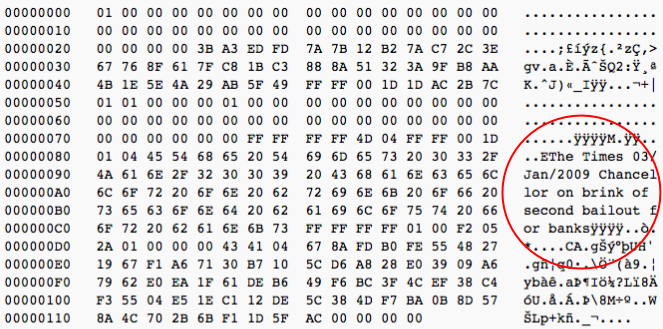On October 31, 2008, when a pseudonym named Satoshi Nakamoto published a white paper entitled "Bitcoin: A Peer-to-Peer Electronic Cash System", perhaps not everyone realized that it would one day become the most famous digital currency.

On January 3, 2009, Satoshi launched the Bitcoin network by mining the first block. Today, this is known as a genesis block.
A genesis block always has a few special features that distinguish it from other blocks in the blockchain.
As you already know from our previous block trainer 1×1, the blocks are each chained to their previous neighbors. You can also read everything you need to know about this in our article "What is a blockchain?".
The genesis block is particularly important as it acts as a kind of "fixed anchor" in all software applications.
The first special feature is that there were no predecessor blocks before the genesis block. In this case, we refer to the block height as "0", as all blocks are based on this. For this reason, the value of the hash of the predecessor block is set to zero. This means that no data was ever processed before this block.
You can find out what a hash is in the following article!
Given that the Bitcoin Genesis block is the origin of the entire crypto ecosystem, it is highly relevant to take a closer look at it. In contrast to other blockchains, the Bitcoin Genesis block has a flaw. This means that the mining reward of 50 BTC sent to the address 1A1zP1eP5QGefi2DMPTfTL5SLmv7DivfNa can never be spent. However, other transactions sent to this address could be used. To this day, no one knows whether this specificity was implemented intentionally or accidentally by Satoshi.
Furthermore, the block time of the genesis block, or actually that of the subsequent block, offers another special feature. Let's take a look at the timestamps of the genesis block (block 0) and the subsequent block:
Since the Bitcoin protocol is programmed in such a way that a new block should actually be found every ten minutes on average, a period of just under six days is extremely strange. Many assume that Satoshi had tested the Bitcoin network in the meantime, as he only published the software and the project via email on January 8, 2009. It is also assumed that Satoshi waited until there was at least one other participant in the network in order to create equal opportunities.
Each block of a blockchain consists of various components. One of these is the so-called Coinbase transaction. It is also described as the first transaction that a miner places in a block they have created. And it is also the transaction that rewards the miner for finding a valid block.
In our block trainer 1×1: "What is mining?" you can also read again exactly why this process is so important for a blockchain.
Satoshi left a special note in the Coinbase transaction of the Bitcoin Genesis block, demonstrating that it is also possible to send messages via transactions.
This reference from January 3, 2009 in the English daily newspaper "The Times" contained the following title:
"The Times 03 / Jan / 2009 Chancellor of the Exchequer close to putting together second bailout package for banks"
~Satoshi Nakamoto

The headline addressed the 2008 economic crisis and the subsequent bank bailout, which Satoshi criticized so strongly and which was his reason for developing the Bitcoin network in the first place. At the same time, he wanted to demonstrate that no mining had taken place before January 3, 2009 and that he did not want to enrich himself by doing so. However, as it was not clear at the time that Bitcoin would ever have any value, this is not particularly relevant anyway.